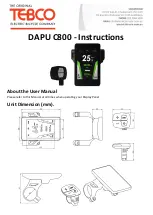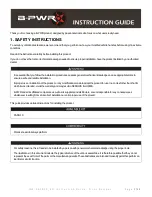
18
For individuals greater than 80 lbs.
(36 kg): use two (2)
tether hooks attaching one (1) tether hook to the tether
anchor immediately behind the restraint AND one (1) tether
hook to the closest adjacent tether anchor.
See Figure 8
.
5. Remove any slack in the tether by pulling the loose ends of the
tether through the tension adjuster hooks.
6. Verify that the tether is appropriately attached and tensioned as
noted above.
Non-LATCH Vehicle Installation:
If the desired seating position in the
vehicle does not have a LATCH top tether anchor (which may be the
case for vehicles that were made before 2002), it is necessary to use a
bolt-in anchor mounting bracket to secure the tether strap. Contact
Columbia Medical directly for more details on acquiring an anchor
mounting bracket.
Figure 8: Double hook
attachment for
individuals over 80 lbs.
(36kg)
Figure 9: Tether
Anchoring Methods
11
5.
Pull the seat belt out completely to engage
the retractor, then route the belt between the
back of the restraint and the metal tubes
which are located along the sides of the
Positioning Restraint System.
6.
Make sure that the seat belt is not twisted,
then buckle in place.
7.
Make sure the restraint system is flat against the vehicle seat’s
bottom and back. Use your hands to apply firm pressure to the
restraint, pushing it into the vehicle backrest—or place your knee on
the restraint and push down with all your weight—-while pulling on the
vehicle seat belt and removing all slack from it.
8.
Check to make sure the tether strap is not twisted and then tighten to
secure the upper portion of the restraint. If the vehicle does not have
a top tether anchor point, it will be necessary to use a bolt-in anchor
mounting bracket.
See Non-LATCH Vehicle Installation.
9.
DO NOT USE
this restraint without the tether strap properly installed.
10.
Verify that the vehicle seat belt is tight and that the Positioning
Restraint System is secure. When properly installed, the restraint will
not move more that 1” (25mm) from side to side and or front to back.
If the restraint is not secure, repeat steps 5 – 8.
Vehicle Lap and Shoulder Belt – Requires Locking Clip
This method of installation is required when installing the Therapedic
Positioning Restraint System in a vehicle with an emergency locking
retractor (ELR) type of seat belt.
Emergency Locking Retractor (ELR)
function allows the occupant to have free movement while buckled up, but
in the event of an emergency situation, such as heavy braking or collision,
the retractor instantly locks securing the occupant. This type of seat belt
is "webbing sensitive," meaning that any sudden movement of the
webbing (the seat belt strap) causes the retractor to instantly lock.
A
locking clip is required to achieve the proper tension when using
this belt type to secure a restraint.
































